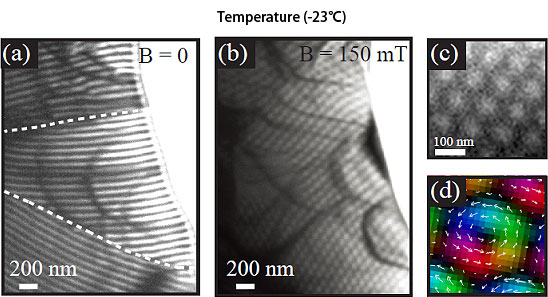Driving an Electron Spin Vortex “Skyrmion” with a Microcurrent
Large Advance toward Realization of Technology for Manipulation of Magnetic Information with Low Current Density 1/100,000th that of Conventional Technology
2012.08.08
(2012.08.27 Update)
RIKEN
The University of Tokyo
National Institute for Materials Science
RIKEN, the University of Tokyo, and NIMS succeeded in forming a skyrmion crystal, in which electron spin is aligned in a vortex shape, in a microdevice using the helimagnet FeGe, and driving the skyrmion crystal with an ultra-low current density less than 1/100,000 that of the current necessary to drive magnetic domain walls in ferromagnets.
Abstract
Magnetic memory devices that use the direction of electron spin, which is the source of magnetism, as digital information have attracted attention as devices with the important features of high speed and non-volatility, etc. In recent years, numerous attempts have been made to manipulate that magnetic information electrically without utilizing a magnetic field. If a current is passed through a ferromagnet, it is possible to move the magnetic domain walls, which are the boundaries between domains where magnetization is upward-oriented and domains with downward orientation (at domain walls, the direction of magnetic spin gradually changes). Therefore, reversal of magnetization becomes possible and information can be written. However, in order to drive the domain walls in this manner, a large current density of at least approximately 105 A/cm2 was necessary. Because this causes large energy loss, in other words, large energy consumption, a method of manipulating magnetic information media with a smaller current density had been desired.
The research team investigated various functional magnetic materials, and in 2010, succeeded in forming and observing a skyrmion crystal by applying a weak magnetic field of less than 200 millitesla (mT) to a thin slice of the helimagnet FeGe at near room temperature. In the present research, the team fabricated microdevices with a length of 165μm, width of 100μm, and thicknesses of 100nm to 30μm using the same FeGe. When a magnetic field of approximately 150mT at temperatures from -23°C to near-room temperature (-3°C) was applied, skymrion crystals in which a stable skyrmion with a diameter of about 70nm was aligned in a triangular lattice shape were observed. The team succeeded in driving the skymrion crystal with an ultra-low current density (the minimum density is approximately 5A/cm2), which is less than 1/100,000th that required to drive magnetic domain walls in conventional ferromagnets. The fact that the skymrion can be driven with this extremely low current density represents the first step toward the development of low power consumption magnetic memory devices using skymrions as an information medium. Various applications can also be expected in the field of spintronics, which is currently an area of active research as a next-generation electronic technology.
The main portion of the research result was achieved in the “Quantum Science on Strong Correlation” project (Core Researcher: Yoshinori Tokura) of the Funding Program for World-Leading Innovative R&D on Science and Technology (FIRST) of the Japan Society for the Promotion of Science (JSPS), with system design by the Council for Science and Technology Policy, and was supported by the JSPS. Part of the research was also supported by the Strategic Basic Research Programs/ERATO (Exploratory Research for Advanced Technology) Type Research Projects of the Japan Science and Technology Agency (JST) and the Nanotechnology Network of Japan’s Ministry of Education, Culture, Sports, Science and Technology (MEXT), and has been published in the online edition of the British science journal “Nature Communications” on August 7 (August 8 Japan time).

Fig. :Magnetic structure observed by Lorentz transmission electron microscopy.
(a) Helical stripe structure in the zero magnetic field. Dotted lines show the crystal grain boundary.
(b) Skymrion crystal formed by applying a 150mT magnetic field perpendicular to the device.
(c) Enlarged diagram of the skyrmion crystal.
(d) Distribution of magnetization in a single skyrmion. Colors and arrows show the direction of electron spin in the skyrmion.
